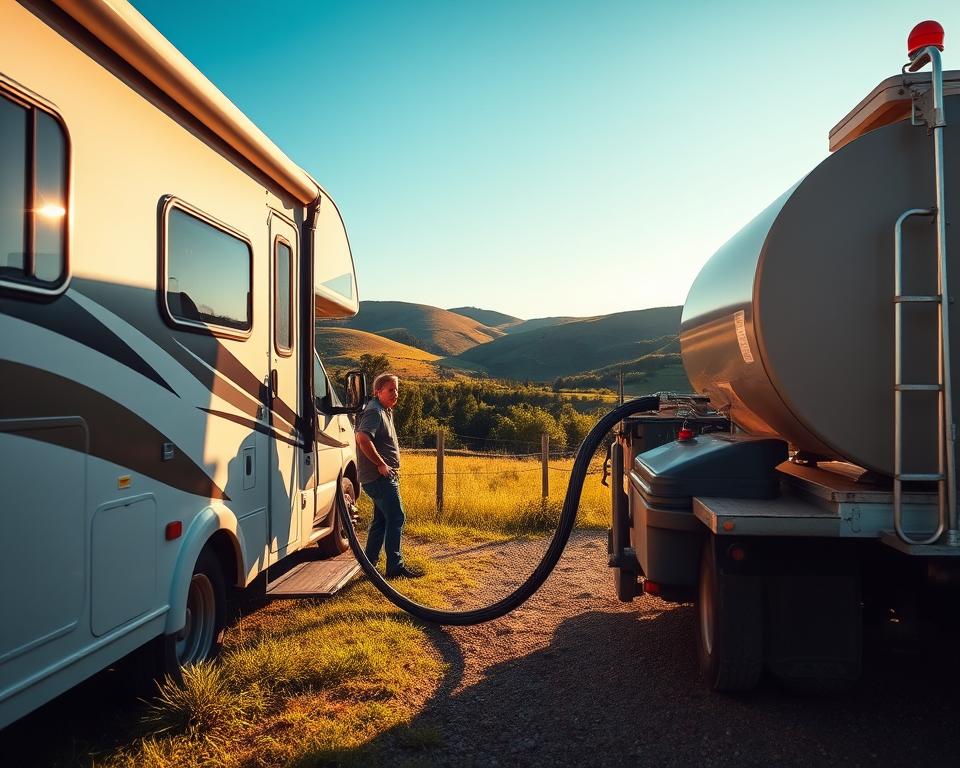Camper Septic Pumping Guide: Essential Tips
Have you ever wondered what could happen if you neglect your RV’s septic unit? Picture the disaster of waking up to a foul smell and a failing sewage system while camping. Keeping your camper septic pumped and waste management are vital to a trouble-free journey. Our guide covers RV sewage disposal, motorhome waste removal, and portable toilet tips. Armed with knowledge on your RV’s septic system, you’ll dodge problems and fully enjoy your excursions.
Major Takeaways
- Understanding your RV septic layout is key for effective maintenance.
- Regular camper septic pumping ward off costly repairs.
- Understand the proper practices for RV sewage disposal.
- Utilize professional services like All in Sanitation for efficient waste management.
- Head off odors and clogs with consistent checks and maintenance.
Understanding Your RV Septic System
Understanding how your RV septic system works is critical to managing waste effectively – RV tank pumping. The arrangement features three main reservoirs: the black tank for toilet waste, the gray reservoir for sink and shower water, and the freshwater tank. Drain pipes, 50 mm for sinks and three-inch for toilets, handle waste movement. Recognizing these elements is important for routine upkeep and on-time waste removal.
The primary waste tank is crucial for sewage management in an RV. It calls for frequent emptying to ward off overfills and foul smells. Using a recreational vehicle septic service for this task can boost your system’s lifespan. The gray reservoir also requires attention to avoid clogs from stagnant water.
Comprehending the inner workings of your RV septic system helps you to manage it better. Scheduled checks and cleanings not only extend your RV’s life but also cut health hazards from septic failures.
Why Camper Septic Pumping Matters
Routine camper septic pumping is key for your RV’s waste management system. Overlooking pumping needs can result in clogs and backups. These issues not only hamper your system but also jeopardize the environment by contaminating local ecosystems.
Utilizing professional sanitation services guarantees efficient waste disposal. Companies like All in Sanitation furnish dependable camper septic pumping. This supports your system and defends the environment. A properly cared-for septic system translates to a cleaner, safer environment for campers and nature lovers.
In short, regularly scheduling septic pumping prevents costly repairs and delivers a better camping experience. Pre-emptive waste management serves personal health and the earth, emphasizing its importance for RV owners.
RV Septic Pumping Frequency
The frequency you must pump your RV’s septic reservoir directly affects its performance. It depends on how many people are using it and the volume of the tank. It is generally wise to empty the primary waste tank every three-to-five days. If you wait too long, waste can harden, making it harder to clean out.
Watching reservoir levels is essential for maintaining your RV’s waste system. Aim to dump the waste when the tank is about two-thirds full. Overfilling can lead to spills, foul smells, and hefty damage. Regular maintenance and immediate attention to the waste levels secure a trouble-free journey.
Proper Tank Emptying Steps
Correctly emptying your RV reservoirs stops undesirable scenarios. Begin by draining the black tank, followed by the gray reservoir. This method minimizes minimal contact with waste, elevating hygiene.
It’s essential to use a leak-proof sewer hose. A sturdy hose avoids spills and boosts safety during waste disposal. After emptying, fully flushing the black tank is critical.
For a thorough clean, employ a built-in black tank flush or a reservoir rinser. These tools efficiently dislodge residues, making sure the reservoir is properly sanitized.
Choosing the right disposal sites is important for responsible waste management. Ideally, use designated dump stations for RV waste water disposal. Companies like All in Sanitation also supply mobile pump-out services, adding convenience for RV users.
Dumping Waste Correctly
Dumping waste from your RV is an unavoidable task that requires close attention to secure a smooth process. First, emptying the primary waste tank, which holds solid waste. Once the primary tank is emptied, move on to the gray reservoir. This method effectively rinses the sewage hose, minimizing residue and odor.
Ahead of attaching the camp toilet hose, completely check your waste hose’s connections to avoid leaks. A reliable attachment safeguards your equipment and ensures a clean environment for camper holding reservoir pumping. Upon completion of dumping, verify the valves are securely closed then disconnecting any hoses.
Dumping can be completed either at specialized dump stations or at sites with full hookup facilities. Both methods require following recommended procedures to maintain hygiene and efficiency in RV waste management.
Keeping Odors & Clogs Away
To stop unpleasant smells, RV septic systems need proper upkeep. Owners should leave their reservoirs adequately filled with water. Choosing RV-safe toilet paper is important to preventing blockages. It aids in the appropriate breakdown of waste. Frequently adding enzyme-based treatments greatly boosts waste management.

Inspecting the vent pipe often is crucial to prevent clogs and interior odors. Adopting routine cleaning practices, like systematic flushing, can maintain the camping atmosphere fresh and inviting. This guarantees a pleasant experience for all RV campers.
Common Mistakes in RV Septic Handling
Many RV owners sometimes make errors with their septic systems. Knowing these mistakes improves RV black water disposal. A common error is flushing items that don’t break down easily, causing significant clogs and hindering the system’s function.
Letting solids build up due to rare flushing is another issue. Infrequent maintenance leads to buildup, demanding costly repairs. Bear in mind, consistent attention saves both time and resources.
The following list lists common items that should not be flushed:
- Wipes
- Feminine hygiene products
- Certain types of toilet paper
Shunning these errors and using safer RV septic management enables travelers to appreciate their journeys without facing unnecessary septic difficulties.
| Mistake | Consequences | Prevention |
|---|---|---|
| Flushing Non-biodegradable Items | Clogs and blockages | Use only biodegradable toilet paper and proper disposal methods |
| Infrequent Tank Flushing | Solid accumulation and odors | Schedule regular flushing and maintenance |
| Ignoring Manufacturer Recommendations | System inefficiencies | Follow guidelines provided in the RV manual |
Signs You Need Professional Pump-Out
Recognizing when to order mobile home septic pumping is crucial. It prevents major problems later. Indicators like slow drains, unexplained smells, or visible waste hint a professional might be needed.
Lengthy stays or heavy use of your RV lead to more waste than usual. A professional service like All in Sanitation can handle these issues. They make sure your reservoir is properly cleaned, sidestepping clogs. Scheduled maintenance prevents future hassles, enhancing your RV experience.
Long-Term RV Septic Care
Scheduled maintenance is critical to lengthening the life of your RV septic system. A solid RV septic service routine ensures long-lasting function and top performance. This includes not just the deep cleaning of reservoirs but also checking seals and cleaning the system thoroughly to head off problems.
Incorporating these practices into your camping habits aids in managing residue buildup, improving waste disposal. Here’s what you should routinely do:
- Clean tanks thoroughly every few months.
- Inspect seals for wear and tear to head off leaks.
- Sanitize the system to get rid of bacteria and odor.
- Check hoses and connections for damage.
Taking these steps in advance assists RV owners dodge pricey repairs later, delivering a smooth camping journey. Proper septic system maintenance boosts your outdoor adventures, making them more fun.
Promoting Waste Management Awareness
Guiding RVers smart waste management is vital for a sustainable environment at campgrounds. Showcasing the proper methods can head off issues like clogs and nasty odors.
To raise awareness, implementing clear educational signs is valuable. Such signs should plainly state what can and cannot be put into sewer systems, reducing errors.
To further educate, campground owners might run workshops on sanitation. These give hands-on demonstrations on correct waste management. Distributing brochures and flyers also bolsters underline the need for responsible disposal. Knowing the correct procedures elevates the camping experience for everyone.
Bringing It All Together
Effective camper septic pumping and diligent RV sewage disposal are vital for a better outdoor experience. Regular maintenance and knowing how your septic system operates are key. They ensure a camping trip without hassles. Employing best practices allows prevent issues like clogs and foul smells, boosting your enjoyment of nature.
Relying on trustworthy services such as All in Sanitation provides expert assistance when you need it. It maintains your RV’s septic system working well and protects the environment. Educating other RVers about important sanitation practices cultivates a community that prioritizes cleanliness and the health of our ecosystem. This forms a pathway for adventures that are both enjoyable and environmentally responsible.
Understanding the details about camper septic pumping and using correct RV sewage disposal techniques lets you immerse with nature without neglecting cleanliness. We should promote awareness and responsibility within the RV community. In unison, we can make our outdoor spaces cleaner and more inviting for all.


